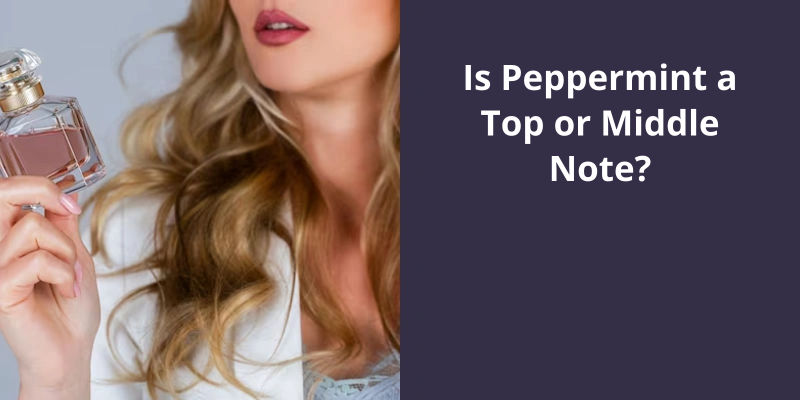Peppermint is generally considered a top note in the world of perfume and aromatherapy. This is due to its powerful and invigorating scent which tends to evaporate quickly. Top notes are the first fragrances you smell when you apply a perfume – they make a strong first impression but don’t last as long. Although it doesn’t linger for an extended period, peppermint’s crisp and refreshing aroma is nonetheless a highly valued component in many fragrance products.

What Is an Example of a Middle Note?
Peppermint is often regarded as a top note rather than a middle note in fragrance compositions. Top notes are the initial scents that are immediately perceived when a fragrance is first applied. They’re typically light, fresh, and tend to evaporate quickly. It provides a burst of freshness and adds a lively touch to any fragrance.
On the other hand, middle notes, also known as heart notes, emerge after the top notes have dissipated. They’re the main body of a fragrance and tend to last longer than the initial top notes. Middle notes are often floral, spicy, or woody in nature. Lavender, pine, and black pepper are examples of middle notes that add depth, warmth, and complexity to a fragrance composition.
Base notes, the final stage of a fragrance, have the lowest evaporation rate. They’re generally rich, warm, and long-lasting. Base notes such as amber, sandalwood, vanilla, and patchouli provide the foundation and depth to a fragrance, complementing the top and middle notes.
Middle notes are an important part of any essential oil or blend, as they make up the body of the fragrance and can last for up to 2 hours. Some commonly used middle note oils include clary sage, geranium, tea tree, and juniper. These oils add depth and complexity to the overall scent profile, creating a harmonious and balanced aroma.
What Essential Oils Are Middle Notes?
When it comes to understanding the different scent profiles of essential oils, it’s important to recognize the concept of notes. In fragrance, notes refer to the different stages of scent that reveal themselves over time. The middle note, also known as the heart note, is the scent that emerges after the top notes have evaporated.
When it comes to identifying middle note essential oils, there are many popular options to consider. Clary sage, with it’s herbaceous and slightly sweet aroma, is a classic middle note oil often used in perfumery and aromatherapy. Geranium, with it’s floral and rose-like scent, is another commonly used middle note that adds depth and complexity to a blend.
Tea tree, known for it’s medicinal and fresh aroma, is also considered a middle note. This versatile oil is often used for it’s powerful antiseptic and antimicrobial properties. Juniper, with it’s woody and earthy scent, is another middle note that’s frequently used in aromatherapy to promote relaxation and clear the mind.
Other Middle Note Essential Oils Include:
Other middle note essential oils include lavender, geranium, rosemary, and ylang-ylang. These oils have a balanced aroma and are often used as harmonizing scents in perfumes and aromatherapy blends. While peppermint is commonly recognized as a top note due to it’s strong and refreshing scent, it can also act as a middle note when combined with other essential oils. It’s cooling and invigorating properties make it a versatile ingredient in various fragrance compositions.
Peppermint essential oil is known for it’s invigorating and refreshing scent. It’s top notes are minty and bring a bright and fresh aroma. In addition, there are undertones of camphor and grass, which add depth to the fragrance. The coolness associated with peppermint is evident in it’s aroma. Interestingly, this versatile oil has a rich history, once used as a digestive aid and even employed to repel rats from living spaces.
What Are the Notes of Peppermint Essential Oil?
Peppermint essential oil is known for it’s invigorating scent and a refreshing burst of minty top notes. These top notes are bright and fresh, instantly awakening the senses with their cooling effect. As you inhale the aroma, you can detect hints of camphor and grass that fill the undertones, adding depth and complexity to the fragrance profile.
Interestingly, the association of peppermint with coolness is evident in it’s scent. The cooling sensation that peppermint imparts can be attributed to the presence of menthol, a compound found in the oil. This compound gives peppermint it’s signature cooling effect, making it a popular choice for use in personal care products like soaps, shampoos, and toothpaste.
Beyond it’s olfactory aspects, peppermint has a rich history of traditional uses. For thousands of years, it’s been used as a digestive aid, helping to ease discomfort and promote healthy digestion. The scent of peppermint can also help to uplift the mood and provide mental clarity.
In addition to it’s therapeutic properties, peppermint has been utilized for pest control. It was commonly used in living environments to chase away rats and other unwanted rodents. The strong and distinct scent of peppermint acted as a natural repellent, making it a safe alternative to chemical-laden pest control methods.
It’s multifaceted nature makes it a beloved ingredient in aromatherapy and everyday products.
Conclusion
In conclusion, peppermint can be considered both a top and middle note in the world of essential oils. While it possesses the freshness and uplifting qualities typically associated with top notes, it also possesses a depth and longevity that’s often found in middle notes. So whether you’re looking for a burst of energy or a soothing calm, peppermint can definitely play a pivotal role in achieving the desired olfactory experience.





